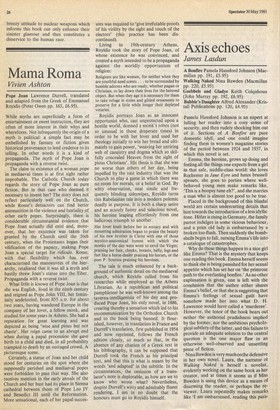Mama Roma
Vivien Ashton
Pope Joan Lawrence Durrell, translated and adapted from the Greek of Emmanuel Royidis (Peter Owen pp. 163, £6.95).
While myths are superficially a form of entertainment or sweet instruction, they are often of more interest in their whys and wherefores. Not infrequently the origin of a myth is political: a simple fact may be embellished by fantasy or fiction given historical provenance to lend credence to its telling. In other words it is a kind of propaganda. The myth of Pope Joan is propaganda with a reverse twist.
The claim to existence of a woman pope in mediaeval times is at first sight rather improbable. The Catholic Church today regards the story of Pope Joan as pure fiction. But in that case who deemed it necessary to invent her? The story does not reflect particularly well on the Church, while Rome's detractors can find better ammunition in the violence and bestiality of other early popes. Surprisingly, there is considerable circumstantial evidence that Pope Joan actually did exist and, moreover, that her existence was taken for granted by the Church until the 16th century, when the Protestants began their vilification of the papacy, making Pope Joan a special target for ridicule. Rome, with that flexibility which has ever characterised the manoeuvres of the hierarchy, retaliated that it was all a myth and hastily threw Joan's statue into the Tiber. Propaganda with a reverse twist.
What little is known of Pope Joan is that she was English, lived in the ninth century and reigned as Pope John VIII, her femininity undetected, from 855 A.D. for about two years, having wandered Europe in the company of her lover, a fellow monk, and studied for some years in Athens. She had a reputation for great learning and was depicted as being 'wise and pious but not chaste'. Her reign came to an abrupt end when during a papal procession she gave birth to a child and died, in all probability trampled to death by an outraged crowd. A picturesque scene.
Certainly, a statue of Joan and her child stood for centuries on the spot where she supposedly perished and mediaeval popes were forbidden to pass that way. She also receives mention in the early annals of the Church and her bust had its place in Sienna cathedral between those of Pope Leo IV and Benedict III until the Reformation. More sensational, each of her papal succes sors was required to 'give irrefutable proofs of his virility by the sight and touch of the electors' (this practice has been discontinued).
Living in 19th-century Athens, Royidis took the story of Pope Joan, of whose existence he was convinced, and created a myth intended to be a propaganda against the worldly opportunism of religion:
Religions are like women, for neither when they are youthful need scents. . . to be surrounded by humble adorers who are ready, whether pagan or Christian, to lay down their lives for the beloved object, But when they age it is necessary for them to take refuge in stoles and gilded ornaments to preserve for a little while longer their depleted votaries.
Royidis portrays Joan as an innocent opportunist who, cast unprotected upon a hostile world, donned a monk's robes (not so unusual in those desperate times) in order to be with her lover and used her theology initially to win her bread and ultimately to gain power, 'weaving her untiring web of casuistry and dogma which so skilfully concealed Heaven from the sight of pious Christians'. His thesis is that she was no worse than others of her day, being impelled by the vast industry that was the Church to play a game in which there was no room for morals, or a belief in God. By witty observation, neat simile and fre quently blinding sideswipes, Royidis turns this Rabelaisian tale into a modern polemic deadly in purpose. It is both a sharp satire and an acutely funny and salacious novel, his heroine leaping effortlessly from one ludicrous triumph to another.
Her lover knelt before her in ecstacy and with mounting admiration began to praise the beauty of his new brother in Christ with one of those mystico-anatomical hymns with which the monks of the day were wont to extol the Virgin; praising her hair, cheeks, breasts, belly, legs and feet like a horse-dealer praising his horses, or the poet P. Soutsos praising his heroines.
The tale is much enhanced by a background of authentic detail on the mediaeval church, which Royidis culled from his researches while employed as the Athens Librarian. As a republican and political pamphleteer he was well-known among the taverna-intelligentsia of his day and produced Pope Joan, his only novel, in 1886, creating thereby a sensation which led to his excommunication by the Orthodox Church and to the book being banned. It flourished, however, in translation in France and Durrell's translation, first published in 1954 and now reprinted, follows the French edition closely, so much so that, in the absence of any citation of a Greek text in his bibliography, it can be supposed that Durrell took the French as his principal text, and that this is what is meant by the words 'and adapted' in the subtitle. In the circumstances, the omission of a translator's note is deplorable, as how are we to know who wrote what? Nevertheless, despite Durrell's witty and admirably fluent rendering, I am in no doubt that the honours must go to Royidis himself.










































 Previous page
Previous page